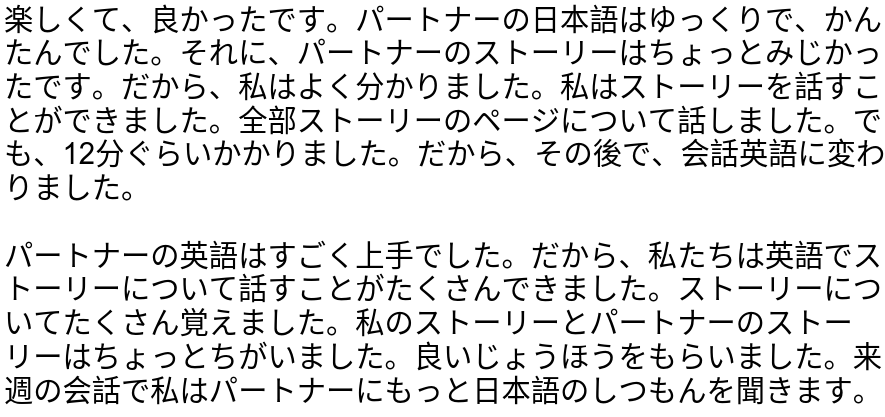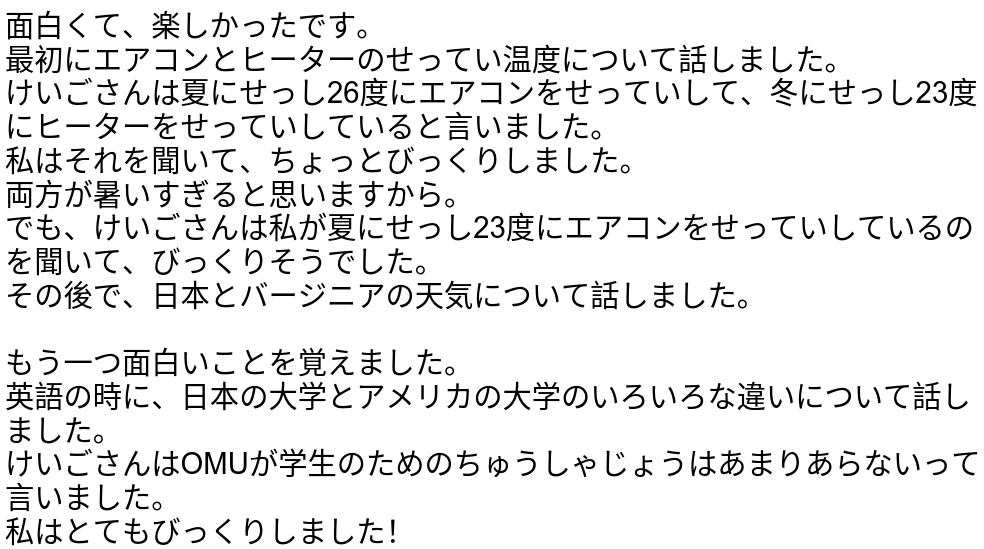Transfer & Connections to Discipline
As a cybersecurity major, one of the primary connections that taking Japanese courses has to my future career goals is learning the importance of international communication skills. Specifically, the bulk of my practice with international communication came from Virtual Language Tables (VLTs), a language exchange program run by Osaka Metropolitan University in collaboration with many US universities. Throughout my Japanese courses at ODU, I had many assigned conversation topics, which provided me with guided conversation practice. However, I could also participate in VLT free talk sessions and practice communicating about any topic I wanted. Not only were these VLT sessions beneficial in helping me practice my Japanese skills, but they were also helpful in learning how to communicate with people from other cultures in English because the sessions were half in Japanese and half in English.
Specifically, I gained valuable experience through trial and error by frequently participating in VLT free talk sessions because conversations were not constrained. When I first started participating in VLT sessions, it was sometimes challenging to keep up conversations in both Japanese and English because of cultural differences. For example, as an American, I am relatively outspoken and willing to break the silence when compared to many people in Japan. I did not realize how much of a difference there was in this regard before gaining experience talking with people in Japan. Initially, there would be long periods of silence, or I would feel like I was doing most of the talking in earlier sessions. I eventually learned that I could use my willingness to talk to start conversations by asking open-ended questions instead of trying to fill the silence with my own thoughts. Furthermore, I also realized the importance of the differences in how people from different cultures show that they are engaged in conversation. While someone in the US may do this by quietly listening and nodding their head, I noticed people in Japan will more often give verbal responses to indicate that they are listening.
By employing the above strategies and being actively conscious about cultural communication differences, I became better at holding deeper conversations. Rather than solely focusing on more surface-level conversations, being more culturally aware made conversations flow better and enabled me to form connections by discussing deeper topics. As a result, my speaking partners and I became more comfortable with each other, leading to more open discussions. This progression in my ability to have deeper, more natural conversations will be the most beneficial skill I have learned to apply to my future career in cybersecurity. Because the internet makes traditional national borders largely irrelevant concerning cybersecurity issues, cybersecurity professionals from many cultures must collaborate to create the most effective solutions. In my future career, the intercultural communication and collaboration skills I have developed are extremely valuable because they will help me break down barriers and enable me to work effectively with others, no matter their backgrounds.
Artifacts
Below are images of the reflections on my first and latest VLT sessions. These examples show how my reflections on VLT conversations went from being either observational or talking about my own thoughts to including more information about my speaking partner’s thoughts. I have also included English translations underneath each example.
First Report/最初のレポート:
Topic/トピック: The Story of Urashima Taro/浦島太郎

English Translation/英語訳:
This session was very fun and went well. My partner spoke slowly in Japanese and used easy vocabulary. My partner’s version of the story was somewhat short, so it was easy for me to understand. I was also able to tell my version of the story and get through all of the pages. However, it took about 12 minutes for me to tell my version of the story, so the conversation turned to English when I finished.
My partner’s English was very good, so we were able to discuss the story in detail in English. Since my partner’s version was slightly different from mine, I learned a lot about the story. I gained valuable information from this session. Next week, I will ask my partner more questions in Japanese.
Last Report/最後のレポート:
Topic/トピック: Inside temperature during the summer and winter/エアコンとヒーターの設定温度

English Translation/英語訳:
This session was fun and interesting. First, my partner and I talked about the temperature we set our air conditioners and heaters to. Keigo said he sets the air conditioner to 26C in the summer and sets the heat to 23C in the winter. I was a little surprised when I heard this because I think both are too hot. However, Keigo seemed surprised when he heard that I set the air conditioner to 23C in the summer. After this, we talked about the difference in the weather between Virginia and Japan.
I also learn something else interesting during this session. When we switched the conversation to English, we talked about the various differences between American and Japanese colleges. Keigo said that OMU does not really have parking lots for students. I was very surprised to hear this!